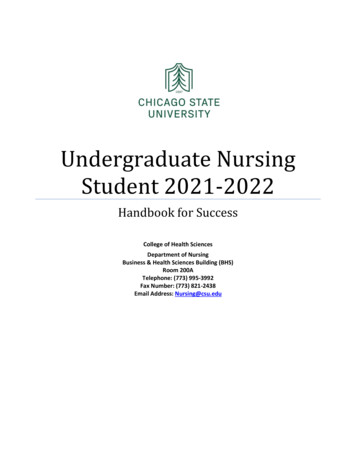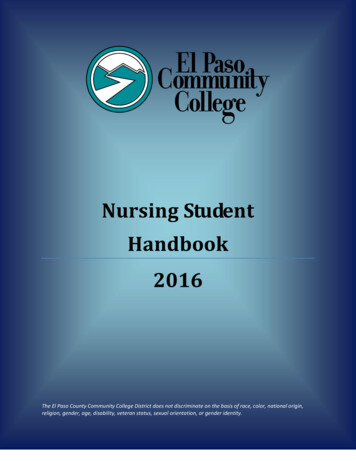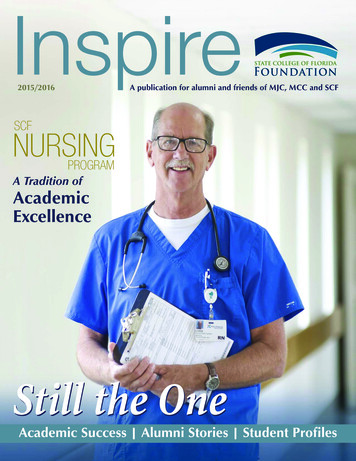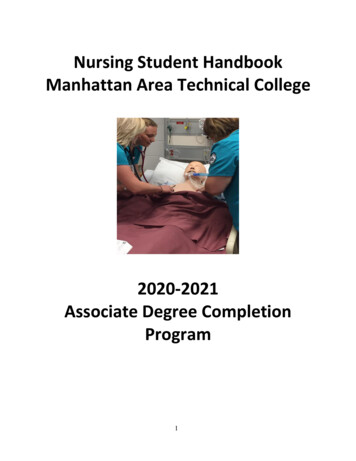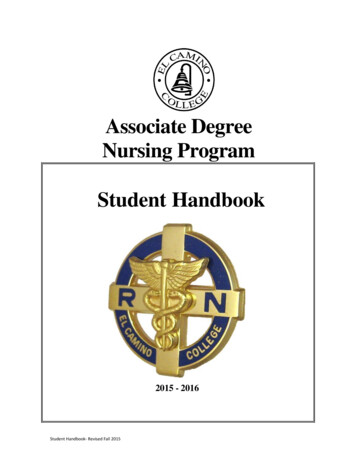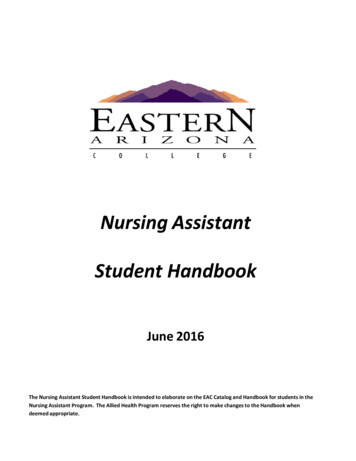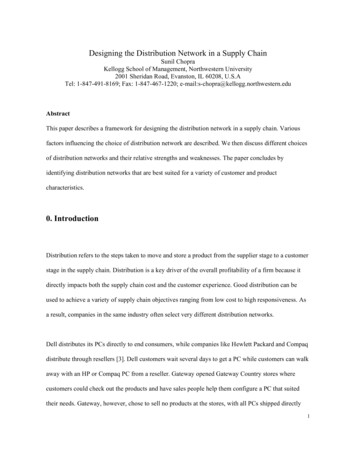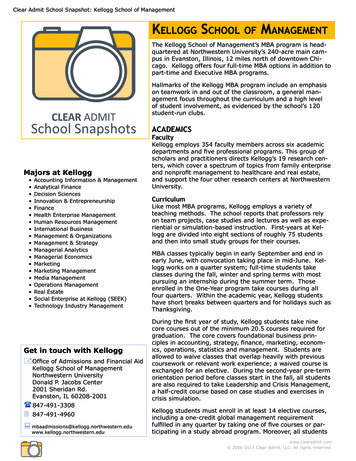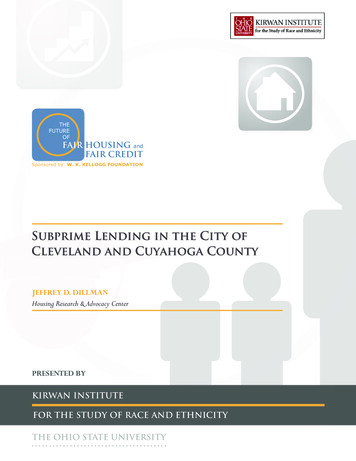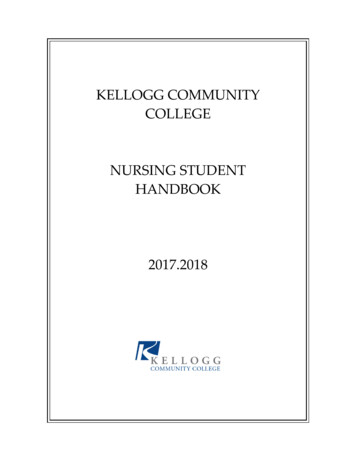
Transcription
KELLOGG COMMUNITYCOLLEGENURSING STUDENTHANDBOOK2017.2018
WELCOME TO NURSING EDUCATION AT KCCThe nursing faculty and staff are pleased and proud that you have chosen to continue youreducation here at Kellogg Community College. We are looking forward to working with you asyou prepare to enter the profession of nursing.The Nursing Student Handbook is a companion to the KCC Student Handbook. The KCC StudentHandbook provides information related to student services, college services, academic services,policies, and procedures. The Nursing Student Handbook provides information and guidelinesspecifically related to the Nursing Programs.Again, we welcome you to the Nursing Programs and hope that you will enjoy the challenginglearning experiences ahead of you.Page 2 of 52
NURSING STUDENT HANDBOOK TABLE OF CONTENTSTable of ContentsNURSING EDUCATION AT KCC . 5Mission. 5Philosophy. 5Teaching Philosophy. 5End-of-Program Student Learning Outcomes . 5Integrated Concepts . 6Core Values . 6Conceptual Framework . 7Nursing Program Full Time Faculty, Staff and Administrators . 8POLICIES . 10Academic Integrity. 10Advanced Placement Admission . 10Americans With Disabilities Act . 10Attendance . 10Bereavement Leave . 11Calling In . 11Child Care . 12Clinical Dress Code . 12Clinical Experiences . 14Clinical Skills General Policies . 14Clinical Placement Assignments. 15Closing Information . 15Clinical Skills by Course . 16Clinical Skills: Do This, Not That . 17Code of Conduct – KCC . 18Communication to Students . 18Criminal Background Checks (updated June, 2017) . 18Dosage Calculation Exam . 18Dosage Calculation Rules plus Standard Rounding Rules . 19Drug Screen . 19Page 3 of 52
Evaluations . 20Flip Camera Policy . 20Food Statement . 20Grading . 21Health Examinations, CPR Certification, Professional Liability Insurance & Pregnancy. 21KAPLAN . 23LATEX Environment Statement. 23Learning Contract . 23Sample Learning Contract . 24Math Competency . 25Medication Administration During Clinical Experiences. 25Moodle – Student Participation . 25Nursing Skills Lab . 25Nursing Supply Kits Level I and Level II . 26Nursing Student Code of Conduct . 26Nursing Students - Organizational Chart . 28Nursing Student Due Process. 28Procedure for Infractions of the Nursing Student Code of Conduct . 28Personal Injury in the Clinical Area. 28Program Progression . 29Program Sequence . 30Readmission Policy. 33Program Changes (from full-time to part-time, part-time to full-time) . 33Skills Validation. 34Student Complaint Procedures . 34Student Representation . 34Technology and Social Networking. 34Testing Policy (Classroom Exams). 36FORMS . 48Agreement To Comply with KCC Nursing Student Handbook . 49College Image and Comment Release Form . 50Nursing Education Confidentiality Agreement . 51Student Release of Information Consent Form . 52Page 4 of 52
NURSING EDUCATION AT KCCMissionThe Kellogg Community College Nursing Program provides excellent educational experiencesthat integrate knowledge, skills, and attitudes needed to prepare safe and competent nursegeneralists who provide quality nursing care in a culturally diverse, global society. Through thespirit of inquiry and professional identity the nurse generalist develops sound clinical judgmentthat promotes teamwork, collaboration and personal growth.PhilosophyNursing discipline and nursing education are essential to the preparation of the nurse generalistto practice in a global, culturally diverse, and rapidly changing health care environment. A cultureof integrity is embraced in which open communication, ethical decision making, and humility areencouraged.Our actions demonstrate our commitment to ourselves and others in the larger community. Thenurse advocates for the individual, family, and community by initiating caring behaviors in aneffort to build helping relationships and to promote a healing environment. Patient-centerednessis embraced utilizing a holistic caring approach incorporating culture, values, traditions, andspiritual beliefs.Nursing education is research based, reflective of health care trends, incorporating quality,patient safety, innovative technology, and creative instructional methods. A culture of excellenceis fostered reflecting a commitment to continuous growth, improvement, and understanding.Each student brings diverse knowledge, skills, attitudes, life experiences, learning needs, andstyles requiring varied approaches to the learning process. Nurse Educators design studentcentered, individualized learning experiences for diverse student populations. The role of theNurse Educator within the nursing program is one of guiding, facilitating, and mentoring topromote life-long learning.Teaching PhilosophyLearning is a growth process facilitated by a caring and collaborative relationship betweeneducator and student. The nursing faculty believes that teaching is a dynamic process thatintegrates principles of adult learning. The nursing faculty incorporates a variety of evidencebased teaching strategies to accommodate various learning styles.The student should actively participate in the learning process, using experience and guidanceoffered by faculty; assuming responsibility for meeting learning outcomes, through the applicationof clinical reasoning into practice. The faculty create a sense of community within the classroomby providing a safe environment, role modeling, promoting effectual communication, professionalbehaviors, and by valuing the diversity and uniqueness of each individual.End-of-Program Student Learning OutcomesHuman FlourishingSupports nursing advocacy for patients and families in diverse patient populations.Spirit of InquiryIncorporates evidence that underlies nursing practice to improve quality of care for patients andfamilies, and communities in diverse patient populations.Page 5 of 52
Nursing judgmentIncorporates evidence to provide safe, quality care in diverse patient populations.Professional IdentityModels professional, ethical and legal responsibility for safe, quality care.Integrated ConceptsContext and EnvironmentThe conditions or social system within which the organization’s members act to achieve specificgoals. Context and environment are a product of the organization’s human resource, and also thepolicies, procedure, rewards, leadership, supervision, and other attributes that influenceinterpersonal interactions. In health care context and environment encompass organizationsstructure, leadership styles, patient characteristics, safety climate, ethical climate, teamwork,continuous quality improvement, and effectiveness. (NLN, 2010, page16-17)Knowledge and ScienceThe foundation that serves as a basis for nursing practice which, in turn, deepens, extends, andhelps generate new knowledge and new theories that continue to build the science and furtherthe practice. (NLN, 2010, page 20-21)Personal/Professional DevelopmentA lifelong process of learning, refining and integrating values and behaviors that are consistentwith the profession’s history, goals, and codes of ethics that serve to distinguish the practice ofnurses from those of other health care providers and give nurses the courage needed tocontinually improve the care of patients, families, and communities and to ensure the profession’songoing viability. (NLN, 2010, page 23)Quality and SafetyThe degree to which health care services are provided in a way consistent with currentprofessional knowledge, minimize the risk of harm to individuals, populations, and providers, toincrease the likelihood of desired health outcomes and are operationalized from an individual unit,and systems perspective. (NLN, 2010, page 25)Relationship-Centered CareHaving (a) caring; (b) therapeutic relationships with patients, families, and communities; and (c)professional relationships with members of the health care team at the core of nursing practice. Itintegrates and reflects respect for the dignity and uniqueness of others, valuing diversity, 62integrity, humility, mutual trust, self-determination, empathy, civility, the capacity for grace, andempowerment. (NLN, 2010, page 27)TeamworkFunctioning effectively within nursing and interprofessional teams, fostering opencommunication, mutual respect, and shared decision-making to achieve quality patient care.(NLN, 2010, page 30)Core ValuesCaringPromoting health, healing and hope in response to the human condition.Page 6 of 52
DiversityRecognizing differences among persons, ideas, values and ethnicities, while affirming theuniqueness of each.EthicsReflectively considering personal, societal, and professional values, principles and codes thatshape nursing practice.ExcellenceCreating and implementing transformative strategies with daring ingenuity.HolismEnsuring that the culture of human caring in nursing and health care affirms the human personas the synergy of unique and complex attributes, values, and behaviors, influenced by thatindividual environment, social norms, culture values, physical characteristics, experiences,religious beliefs and practices, and moral and ethical constructs, within the context of a wellnessillness continuum.IntegrityRespecting the dignity and moral wholeness of every person with conditions or limitations.Patient-centerednessEnsuring the orientation to care incorporates and reflects the uniqueness of an individualpatient’s background, personal preferences, culture, values, traditions, and family.Conceptual FrameworkPage 7 of 52
Nursing Program Full Time Faculty, Staff and ds-FoyTonieMcMasterJodiPenningtonAbbyPeroPage 8 of 52
Nursing Education Organizational Information / Contact InformationMain College phone number 269-965-3931Full-time FacultyKimberly Barnes-Kalkowski, ext. 2331barneskalkowskik@kellogg.eduKathy Newton, ext. 2307newtonk@kellogg.eduKathy Bess, ext. 2319bessk@kellogg.eduJennifer Rodriguezrodriguezj@kellogg.eduDebra Buck, ext. 2744buckd@kellogg.eduLynn Smolarkiewicz, ext. 2312smolarkiewiczl@kellogg.eduElizabeth (Liz) Fluty, ext. 2420flutye@kellogg.eduTemple Stovall, ext. 2310stovallt@kellogg.eduLisa Johnson, ext. 2116johnsonl3@kellogg.eduLiia Thatcher, ext. 2418thatcherl@kellogg.eduKaren Kulhanek, ext. 2317kulhanekk@kellogg.eduGeorgina Thomas, ext. 2278thomasg@kellogg.eduRenee Mielke, ext. 2733mielker@kellogg.eduNursing Departmentext. 2305, nursing@kellogg.eduSecretary, Nursing DepartmentJodi Pennington, ext. 2311, penningtonj@kellogg.eduNursing Program Specialist, Nursing DepartmentAbby Pero, ext. 2318, peroa@kellogg.eduCoordinator, Nurse Aide Training ProgramPamela Edwards-Foy RN, ext. 2362, edwards-foyp@kellogg.eduDirector, Nursing EducationTonie McMaster MSN, RN, CNE, ext. 2327, mcmastert@kellogg.eduDean of Workforce DevelopmentDr. Jan KarazimVice President for InstructionDr. Kevin RabineauPresident of the CollegeMr. Mark O’ConnellPage 9 of 52
POLICIESAcademic IntegrityThe Kellogg Community College policy on academic integrity is spelled out in the StudentHandbook. If it is suspected that you are cheating, fabricating, facilitating academic dishonesty, orplagiarizing, there may be serious consequences. The incident will be documented and may bereported to the College Administration for possible disciplinary actions up to and including course,program, or college expulsion.Students who are members of Kellogg Community College’s Nursing program are expected tohold themselves accountable to the highest standard in regard to honesty, and academicintegrity. While not all inclusive, the following behaviors listed below will be treated as academicdishonesty (aka “cheating”): Obtaining access to and/or use of any materials intended for instructor/faculty use only isstrictly prohibited. Course book test banks are developed for faculty use only. Studentsmay not obtain, gain access to, distribute or use these test banks. If a student is unsure ifuse of particular study materials is acceptable, they are responsible to check immediatelywith their classroom faculty. Any student discovered accessing instructor test bankresources is subject to dismissal from the program. Discussing exam questions/answers with students who have not yet taken the exam. Photographing or making a copy of any part of an exam or quiz. Sharing completed assignments with other students who have not yet completed theassignment (outside of a designated student group activity). Discussing simulated clinical experiences with other students. Sharing the learningexperience with students who have not yet participated in the simulation impedes thelearning experience intended for all.Advanced Placement AdmissionSee KCC Academic Catalog regarding admission to the LPN-to-Associate of Applied Science inNursing degree. Advanced Placement applicants may identify their preference for full-time orpart-time level two nursing course work. Advanced Placement students are notified by theDirector of Nursing Education if seats are available for the full-time or part-time options near theend of Transitional Nursing (NURS 136). Students may register for level two nursing coursesfollowing notification by the Director of Nursing Education.Americans With Disabilities ActKellogg Community College does not discriminate in the admission or treatment of students onthe basis of disability. KCC is committed to compliance with the Americans with Disabilities Actand Section 504 of the Rehabilitation Act. Information is available m, clinical and lab attendance is necessary for successful completion of nursing courses.Attendance is required to meet course outcomes and clinical objectives of the course. Tardinessin a clinical or lab area is considered an unprofessional behavior and is not acceptable. A nocall/no show to the clinical or scheduled laboratory or simulation setting is a serious occurrenceand could result in a clinical failure. If a student has a no call/no show occurrence, it will beinvestigated and addressed on an individual basis.If a student does not complete the clinical component of the course it will result in a letter grade of“F” for the course. If a student fails clinical for attendance, or any other reason, the student is notPage 10 of 52
permitted to return to clinical after being notified of the clinical failure. Pre-planned clinical or lababsences (i.e. vacation, appointment, etc.) will be considered an absence occurrence for eachday or evening missed. Make-up assignments will still be required.If a student does not successfully complete the clinical component of a nursing course, thestudent is not permitted to return to clinical after being notified of the clinical failure. The studentmay not finish the theory component of the course in which the clinical failure was issued. (SeeProgram Progression and Readmission Policies).A student’s documented illness/childbirth resulting in two subsequent clinical attendanceoccurrences could be considered one occurrence, depending on the situation. It will be assessedand addressed on an individual basis by the classroom faculty, clinical instructor and the Directorof Nursing Education.For each nursing clinical or scheduled lab or simulation experience, an attendanceoccurrence of tardiness; leaving the clinical or lab early; or absence will all be treated equally withthe following guidelines:1st Attendance Occurrence – A learning contract will be initiated by the clinical or classroomfaculty, including a make-up assignment as determined by the instructor.2nd Attendance Occurrence – A second learning contract will be initiated by the clinical orclassroom faculty with a second make-up assignment as determined by the instructor. Thesecond learning contract will identify in the “Outcomes/Consequences” area that anotheroccurrence will result in a clinical failure of the course.3rd Attendance Occurrence – A clinical failure will be issued for the course. (See ReadmissionsPolicy)Bereavement LeaveAny nursing student who is absent from either the theory or lab/clinical component of the programdue to a death of an immediate family member must inform the classroom faculty and theProgram Director in writing of the circumstances. When a death occurs in a student’s immediatefamily, they may take up to five (5) consecutive days off to attend the funeral or make funeralarrangements. Immediate family member is defined as parent, child, spouse, life partner, siblingor grandparent. Upon notification of the death and submission of verifying documentation, theclassroom faculty and Program Director will work with the student to create an individualizedlearning plan to meet the clinical outcomes for the clinical time missed and follow up on missedclassroom assignments and exams. Appropriate documentation is a death certificate, obituary ordeath notice. If the documents do not clearly indicate the relationship of the deceased to you,please supply document(s) that do indicate the relationship.Calling InIf it is necessary to miss a scheduled or arranged clinical or lab day, the student is required to doall of the following before the start time on the day of the absence: Call the clinical instructor at least one hour before the clinical is scheduled to begin. Textand e-mail call-ins are not acceptable.If the clinical instructor cannot be reached, call the clinical site and leave a detailedmessage for the clinical instructor.Notify the classroom faculty at the College via telephone. If he or she is not in the office,leave a voice mail message explaining the absence.If the main campus cancels classes because of severe weather, classes and clinical experienceswill be canceled.Page 11 of 52
Child CareChildren are not allowed to be brought into the classroom or clinical/lab portion of any course,during scheduled time. This also applies to the nursing computer labs located in the Roll Building,rooms 202 and 211.Clinical Dress CodeBasic Clinical UniformA royal blue uniform is required for clinical/lab/specific class assignments. The uniform includes aV neck scrub top (several styles available), and pants (straight leg or knit ankle cuffs). A white labcoat (“Jacket”) is optional. The uniform brand must be White Swan and an approved styleindicated below. Students may wear a bright white, short sleeve or fitted long sleeve, shirt underthe royal blue uniform top. Burnout patterns are not permitted. Students will be notified of specificrequired uniform styles before they will be needed for lab/clinical/class. White shoes with veryminimal amount of color (leather or leather-like with a closed toe and heel) and white sockscomplete the uniform. Student uniforms are to be worn only for KCC scheduled or arrangedclinical/lab/specified class times. Nursing Program uniforms and name badges may not be worn ifthe student is in any capacity other than a KCC nursing student.White Swan StyleFundamentalsCodeNumberColorJacket – Ladies15104WhiteJacket – Men15103WhitePant-Unisex(draw string, 1 cargopocket)Pant-Ladies(pull on, seam hem)14920Royal Blue14720Royal BlueV Neck – Unisex14900Royal BlueV Neck – Ladies(2 pockets)V Neck – Unisex(3 pocket)14700Royal Blue14869Royal BluePage 12 of 52
Clinical Agencies’ Dress CodeNursing students must adhere to the dress code policy of the clinical agency to which they areassigned. These policies vary considerably and students will be informed about the specificdress code of the clinical agency prior to their clinical experience.Students must follow the guidelines below for ALL clinical experiences: KCC nursing student picture identification. Hair color must be a natural color. Any visible tattoo should be covered. No cleavage, or bare midriff may be revealed. Perfume and scented hygiene products must not be used. Students are to be clean, well-groomed and free of offensive body odors. Cigarettesmoke odor is offensive and/or nauseating to many patients. Cigarette smoke odor is notacceptable on a students’ person or uniform, while in the clinical/lab setting. Mustaches and beards must be clean and neatly trimmed A plain wedding band (no stone) is the only type of jewelry that may be worn. Noearrings, necklaces, bracelets, or piercings of any kind are permitted. Flesh-colored inserts may be used to conceal non-traditional piercings. In addition,gauged ears must have flesh-colored inserts and be no larger than 6mm or ¼ inch. Theuse of a ‘Band-Aid’ is not acceptable to cover a body piercing. Fingernails must not extend past the fingertip, must be neatly trimmed and cleaned. Nailpolish is not permitted. Artificial and nails with shellac (including acrylic, gel, sculptured,and wrap nails) are not permitted in any clinical, lab or simulation setting.Specific Clinical Appearance Requirements (When in Uniform)In addition to the requirements listed above, appearance requirements when in uniform are asfollows: Uniforms and lab coats must always be clean and unwrinkled and shoes must be clean. Hair must be secured back, off the collar, and away from the face. If a head covering or partial face cover must be worn for religious or medical reasons, itmust be a solid color of white, black or royal blue. Students must still be able use astethoscope. If religious covering includes a dress, it must be royal blue and cannotproceed past the ankle.Out of Uniform Clinical Dress (Conservative-Business/Casual)There are instances where you will not be wearing the full uniform, but the activities areassociated with clinical experiences, or are themselves clinical activities where uniforms are notrequired/permitted. Conservative business or casual attire includes the requirements listed above“for ALL clinical experiences” and the following: Appropriately fitting, dress trousers or slacks/khaki’s. No leggings with short tops/short dresses. Knee length or longer skirts. Opaque high-necked shirts or blouses. Clean, low-heeled, closed toe and heel shoes. If a head covering or partial face cover must be worn for religious or medical reasons, thestudent must still be able use a stethoscope. If religious covering includes a dress, itcannot proceed past the ankle.Required Clinical Supplies Bandage scissors, stethoscope, penlight, plain watch with a second hand or digitalsecond display, sphygmomanometer (adult size regular blood pressure cuff).KCC nursing student picture identification with badge clip provided by NursingDepartment.Page 13 of 52
Clinical ExperiencesClinical days may occur during any day of the week, including weekends. Clinical hours may takeplace during day, afternoon, evening, or night times depending upon clinical site/lab availability.Numerous clinical facilities are utilized to offer the student necessary clinical experiences. Theclinical facilities may be some distance from the student’s home. It remains the responsibility ofthe student to ensure transportation to the various clinical facilities.Kellogg Community College, the Clinical Instructor, and the Nursing Faculty are not responsiblefor the personal safety of any student or member of the public when students are traveling to orfrom clinical facilities.Students must be registered for the course in order to attend any clinical hours due toProfessional Liability Insurance requirements. (See Health Examinations, CPR Certification &Professional Liability Insurance Policy)All acceptable clinical experiences/hours are those arranged by Kellogg Community Collegerepresentatives solely. There are occasions that clinical orientation must occur at days and timesother than those indicated in the schedule. Students are notified as far in advance as possibleregarding mandatory orientations that fall outside of scheduled course dates or times. If a studentdoes not attend a mandatory orientation, an administrative withdrawal may be necessary for thatcourse. (See Readmission Policy)In order to meet certain clinical facility requirements, it may be necessary to provide the last fourdigits of student’s social security numbers to designated employees of the clinical facilities. Thisinformation is only provided if required.Clinical Skills General Policies Students administering any medications must do so under th
WELCOME TO NURSING EDUCATION AT KCC The nursing faculty and staff are pleased and proud that you have chosen to continue your education here at Kellogg Community College. We are looking forward to working with you as you prepare to enter the profession of nursing. The Nursing Student Handboo


